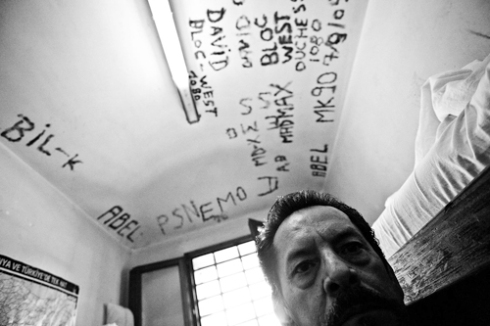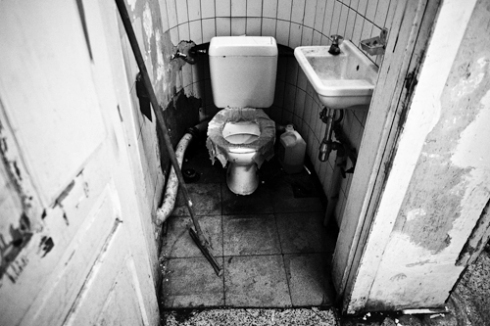
An agent is looking on his colleague during the visit of the food storage in Forest, Brussels, Belgium on Oct. 10, 2011. © Sébastien van Malleghem
Sébastien van Malleghem and Laure Geerts, two members of the photo collective Caravane, have been photographing in Belgium’s prisons for a little under two years. They went to seven prisons including Marneffe, an open prison; Nivelles; Paifve, a prison for the mentally ill; and the now-demolished Verviers Prison. The series is called Destination Carcerale.
This is the first of a two-parter – see Belgian Prison in Polychrome, Laure’s photographs and Q&A also Prison Photography.
I know very little about Belgian prisons so I asked them both some questions.
Q & A
Prison Photography (PP): Your B&W documentary approach to photography is different to Laure’s way of shooting.
Sébastien van Malleghem (SvM): Yes. I chose this approach to photography several years ago. I’m concerned by the world that surrounds us. I like to go deeper into stories and take time to do them.
PP: Why did you and Laure decide to collaborate on this project on Belgian prisons?
SvM: We’re part of a collective. Initially, we talked a lot about doing something together in photography. Laure as always been interested by strong universe (sic)*, and I wanted to continue to work on stories about criminal justice after my long documentary work, Police. (Interview about Police in French.)
It’s a challenge to do reportage together but we wanted to share a vision, and ask ourselves questions about the ways we can create photo documentary. Many documentaries are done alone. After months, it’s interesting to see the difference between our works, especially as we were at the same place all the time – Laure’s colors pictures are different to mine. So, we are questioning objectivity in photojournalism, also.

Three patients smoking at the entrance of their ‘block’ in Paifve, Liège on Feb. 16, 2011. © Sébastien van Malleghem.

A guard is speaking behind a safety glass in Verviers, Belgium on May 6, 2011. © Sébastien van Malleghem
PP: What did the staff expect of your photography and your presence?
SvM: At first, they didn’t seem very interested in the fact we’d received the authorization of the Head Director of the Belgian Prisons, so every director at every single prison would begrudgingly say, “Okay, if you got the authorization, it’s fine.” Then, after few weeks some prison administrations became very interested in our pictures. Some directors began showing us everything inside inside their prisons as if to say, “Look how can we work in these conditions.” So we got some great access and different points of view.
PP: What did the prisoners expect of your photography and your presence?
SvM: Honestly, I don’t think that they expected anything from us. Some of them didn’t want to be seen. Some of them are playing the game of honesty [for the camera]. They expected that the prison conditions may improve. They were interested by our work because we were/are speaking about their present universe. We are showing the reality inside the prison which is not so good. In fact worse than ever in Belgium.
PP: This is a long-term and committed project. What do you hope to achieve with its completion?
SvM: We’re giving a real and true alarm signal to the authorities and to the government; they are looking on our work and they will certainly watch it in the press. That’s will create another debate.
And maybe, with a deep and concrete story, and by showing this work to the public and show why there are so many problems in our prisons, maybe they will get access to a more telling information than that in the daily news-feed?

A woman is sunbathing inside the prison for women of Berkendaele on July 25, 2012. © Sébastien van Malleghem.

Women are dancing in their cells inside the prison for women in Berkendaele on July 25, 2012 © Sébastien van Malleghem.

Cuddle in the courtyard of the prison for women in Berkendaele on July 25, 2012. © Sébastien van Malleghem.

View from the window of the prison in Verviers, Belgium on May 6, 2011. Verviers is one of the oldest prisons in Belgium and is currently being destroyed due to the collapsing of the walls © Sébastien van Malleghem
PP: You depict a prison being demolished. Are there more or less prisons being built/occupied in Belgium currently?
SvM: The government is destroying old prisons like Verviers and building new prisons in the north and the south of the country. The prison was not maintained during years because of budget problems. There is certainly not enough space. Inside the prisons, every inmate is a victim of our society, which is another sign of the actual crisis in our country.
PP: Anything else you’d like to add?
SvM: We should think about the ways we punish criminals in the 21st century and to help victims of crime more too. Currently, we are running with an old system of exile which doesn’t benefit anyone. The authorities remove the prisoners away from the society but put them in the middle of nothing which, seems to me, is another way to torture the spirit. They lock the gates but they are not trying to understand crime, or allieve it.
PP: Thank you Sébastien
SvM: Thanks!
– – – – – – – – – – – – – – – – – – – – – – – – – – – – – – – – – – – – – – – – – – – –
BOOK
van Malleghem’s forthcoming book Police by Yellow Now Editions (Belgium) is released in Belgium in November and will be available internationally from December onwards.

A patient inside his cell, in Paifve, Liège, Belgium on Feb.16, 2011. © Sébastien van Malleghem

Four prisoners are seen inside a cell debating reentry into society after prison. Marneffe, Belgium on Feb. 27, 2011. © Sébastien van Malleghem.

Two patients are eating their meal in the kitchen of the prison of Paifve, Liège, Belgium on March 3, 2011. © Sébastien van Malleghem

Writings made with a lighter on the ceiling are seen in a cell of Forest prison, Brussels, Belgium on Oct. 10, 2011 © Sébastien van Malleghem.

A patient pushed down the courtyard by his roommates in Paifve, Liège, Belgium on Jul. 12, 2011. © Sébastien van Malleghem.

The prisoners of Marneffe have the opportunity to play music in a band. The repetitions takes place inside a chapel inside the prison of Marneffe, Belgium on Dec. 8, 2011. © Sébastien van Malleghem

A prisoner during his daily work: preparing pieces of metal in Marneffe, Belgium on Feb. 27 2012 © Sébastien van Malleghem.

Toilet for the prisoners inside the prison of Forest, Brussels, Belgium on Oct.7, 2011. © Sébastien van Malleghem.
– – – – – – – – – – – – – – – – – – – – – – – – – – – – – – – – – – – – – – – – – – – –
BIOGRAPHY
Sébastien van Malleghem is a freelance photographer (b. 1986, Belgium) who studied photography at the Ecole Superieure Des Arts De L’Image Le 75 in Brussels from 2006 to 2009. He is working on a major project about Belgian police and in line with his interest in criminal justice began documenting the Belgian prisons in January 2011.
Sébastien is a member of CARAVANE photographic collective and is personal assistant to Tomas Van Houtryve/VII. In October 2010, he was selected for the Eddie Adams Workshop, Barnstorm XXIII, and in August 2012, was an artist in residence at Halsnoy Kloster, Norway. Sébastien was awarded
the Jeune Artiste Plasticien for his work Police.
– – – – – – – – – – – – – – – – – – – – – – – – – – – – – – – – – – – – – – – – – – – –

3 comments
Comments feed for this article
September 29, 2012 at 10:03 am
Laure Geerts: Belgian Prisons in Polychrome « Prison Photography
[…] is the second of a two-parter; yesterday, I published Belgian Prison in Grayscale a Q&A with Sébastien van Malleghem. I know very little about Belgian prisons so I asked them […]
April 15, 2014 at 12:46 am
As Reporter and Guinea Pig, Photographer Spends Three Days in New High-Tech Belgian Prison | Prison Photography
[…] In the past, you have shot in black and white (as opposed to your colleague Laure Geerts who photographed in colour) Why black and white here, […]
January 25, 2015 at 1:02 pm
Sébastien Van Malleghem Wins Lucas Dolega Award for Photography in Belgian Prisons | Prison Photography
[…] a big fan of the work having previously interviewed Sébastien while the work was ongoing and applauded the time he spent three-days locked up in Belgium’s newest most high tech […]